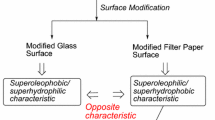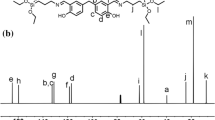Abstract
Silica particles were modified with a poly(4-vinylpyridine) (P4VP) for efficient separation of oil-in-water emulsions. Using a 3-(aminopropyl) triethoxysilane (APTES)-based molecule coupled to an appropriate radical initiator, P4VP chains were built from silica surfaces under mild reaction conditions using surface-initiated supplemental activator and reducing agent atom transfer radical polymerization. P4VP-modified silica particles were successfully used as a pH-switchable barrier for oil/water separation and proved to be efficient in removing oil from an oil-in-water nanoemulsion.














Similar content being viewed by others
References
Haller I (1978) Covalently attached organic monolayers on semiconductor surfaces. J Am Chem Soc 100(26):8050–8055
Taylor A et al (2000) Adhesion of microbes using 3-aminopropyl triethoxy silane and specimen stabilisation techniques for analytical transmission electron microscopy. J Microsc 199(1):56–67
Falsey JR et al (2001) Peptide and small molecule microarray for high throughput cell adhesion and functional assays. Bioconjug Chem 12(3):346–353
Kusnezow W et al (2003) Antibody microarrays: an evaluation of production parameters. Proteomics 3(3):254–264
Gunda NSK et al (2014) Optimization and characterization of biomolecule immobilization on silicon substrates using (3-aminopropyl) triethoxysilane (APTES) and glutaraldehyde linker. Appl Surf Sci 305:522–530
Szwarc M (1998) Living polymers. Their discovery, characterization, and properties. J Polym Sci Part A Polym Chem 36(1):IX–XV
Hadjichristidis N et al (2001) Polymers with complex architecture by living anionic polymerization. Chem Rev 101(12):3747–3792
Li Z et al (2014) Design of polyhedral oligomeric silsesquioxane (POSS) based thermo-responsive amphiphilic hybrid copolymers for thermally denatured protein protection applications. Polym Chem 5(23):6740–6753
Matyjaszewski K, Tsarevsky NV (2014) Macromolecular engineering by atom transfer radical polymerization. J Am Chem Soc 136(18):6513–6533
Matyjaszewski K, Tsarevsky NV (2009) Nanostructured functional materials prepared by atom transfer radical polymerization. Nat Chem 1(4):276
Siegwart DJ, Oh JK, Matyjaszewski K (2012) ATRP in the design of functional materials for biomedical applications. Prog Polym Sci 37(1):18–37
Nicolas J et al (2013) Nitroxide-mediated polymerization. Prog Polym Sci 38(1):63–235
Perrier S, Takolpuckdee P (2005) Macromolecular design via reversible addition–fragmentation chain transfer (RAFT)/xanthates (MADIX) polymerization. J Polym Sci Part A Polym Chem 43(22):5347–5393
Wang J-S, Matyjaszewski K (1995) Controlled/” living” radical polymerization. Halogen atom transfer radical polymerization promoted by a Cu(I)/Cu(II) redox process. Macromolecules 28(23):7901–7910
Matyjaszewski K, Xia J (2001) Atom transfer radical polymerization. Chem Rev 101(9):2921–2990
Matyjaszewski K et al (2006) Diminishing catalyst concentration in atom transfer radical polymerization with reducing agents. Proc Natl Acad Sci 103(42):15309–15314
Magenau AJ et al (2011) Electrochemically mediated atom transfer radical polymerization. Science 332(6025):81–84
Tasdelen MA, Uygun M, Yagci Y (2010) Photoinduced controlled radical polymerization in methanol. Macromol Chem Phys 211(21):2271–2275
Konkolewicz D et al (2012) Visible light and sunlight photoinduced ATRP with ppm of Cu catalyst. ACS Macro Lett 1(10):1219–1223
Jakubowski W, Min K, Matyjaszewski K (2006) Activators regenerated by electron transfer for atom transfer radical polymerization of styrene. Macromolecules 39(1):39–45
Jakubowski W, Matyjaszewski K (2006) Activators regenerated by electron transfer for atom-transfer radical polymerization of (meth) acrylates and related block copolymers. Angew Chem 118(27):4594–4598
Min K, Gao H, Matyjaszewski K (2007) Use of ascorbic acid as reducing agent for synthesis of well-defined polymers by ARGET ATRP. Macromolecules 40(6):1789–1791
Zhang Y, Wang Y, Matyjaszewski K (2011) ATRP of methyl acrylate with metallic zinc, magnesium, and iron as reducing agents and supplemental activators. Macromolecules 44(4):683–685
Matyjaszewski K et al (1997) Zerovalent metals in controlled/“living” radical polymerization. Macromolecules 30(23):7348–7350
Mendonça PV et al (2014) Synthesis of cationic poly ((3-acrylamidopropyl)trimethylammonium chloride) by SARA ATRP in ecofriendly solvent mixtures. Polym Chem 5(19):5829–5836
Zhang T et al (2015) Surface-initiated Cu(0) mediated controlled radical polymerization (SI-CuCRP) using a copper plate. Polym Chem 6(14):2726–2733
Li J-J, Zhou Y-N, Luo Z-H (2015) Smart fiber membrane for pH-induced oil/water separation. ACS Appl Mater Interfaces 7(35):19643–19650
Yang J et al (2018) pH-Responsive poly (dimethylsiloxane) copolymer decorated magnetic nanoparticles for remotely controlled oil-in-water nanoemulsion separation. Macromol Rapid Commun. https://doi.org/10.1002/marc.201800013
Maaz M et al (2017) Surface initiated supplemental activator and reducing agent atom transfer radical polymerization (SI-SARA-ATRP) of 4-vinylpyridine on poly (ethylene terephthalate). J Colloid Interface Sci 500:69–78
Deline V et al (1978) Mechanism of the SIMS matrix effect. Appl Phys Lett 33(9):832–835
Zhang F et al (2010) Chemical vapor deposition of three aminosilanes on silicon dioxide: surface characterization, stability, effects of silane concentration, and cyanine dye adsorption. Langmuir 26(18):14648–14654
Acknowledgements
Many thanks to Mrs. Sandra Mazerat from the “Institut de Chimie Moléculaire et des Matériaux d’Orsay” (ICMMO) for AFM measurements and Mr. Marceau Hénot from the “Laboratoire de Physique des Solides” (Orsay, France) for ellipsometry analysis. The authors would like to acknowledge the “Lebanese National Council for Scientific Research (CNRS-L)” for granting a doctoral fellowship to Mr. Maaz and the Hubert-Curien partnerships for granting a CEDRE Project for 2017–2018. Dr. Elzein acknowledges “L’OREAL-UNESCO foundation” for granting her the “L’OREAL-UNESCO for Women in Science, Levant and Egypt” regional fellowship 2016.
Author information
Authors and Affiliations
Corresponding authors
Rights and permissions
About this article
Cite this article
Maaz, M., Elzein, T., Dragoe, D. et al. Poly(4-vinylpyridine)-modified silica for efficient oil/water separation. J Mater Sci 54, 1184–1196 (2019). https://doi.org/10.1007/s10853-018-2888-x
Received:
Accepted:
Published:
Issue Date:
DOI: https://doi.org/10.1007/s10853-018-2888-x




